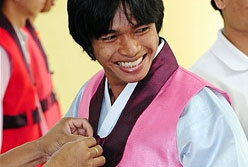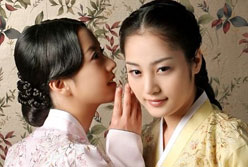 영어토론방 영어토론방 | Home>영어토론방 |
Culture Hanji' Wear Fashion Show Hits Stage
페이지 정보

본문
 Hanbok, or Korean traditional costume, is considered one of the most representative icons of the nation's tradition. But it has generally remained trapped in the past, mostly seen through epic films and dramas.
Hanbok, or Korean traditional costume, is considered one of the most representative icons of the nation's tradition. But it has generally remained trapped in the past, mostly seen through epic films and dramas. It is rare to see modern Koreans donning hanbok in their daily lives, in contrast to the Japanese ``yukata,'' a cotton kimono with stencil-dyed patterns originally designed for comfortable dress in the home by both men and women.
To modernize the traditional costume, Chae Keum-seok ― a professor of the Clothing and Textiles Division of Sookmyung Women's University ― and Jeonju municipal government of North Jeolla Province ― have put together an informal yet traditional form of leisure clothing made from hanji, or Korean traditional paper. The comfortable piece, an upgraded version of the hanbok, is designed for casual outings and rest at home.
To showcase the hanji-made hanbok, the ``Han-Style Fashion Show'' will be held at Fashion Center in Samsung-dong, southern Seoul, on Monday.
At the show, about 125 pieces of hanbok uniforms and casual outfits will be showcased.
These new hanbok focus on simplicity, functionality and sensuality based on the nation's representative images, such as hangeul ― or the Korean alphabet, through a survey of 5,000 experts in various sectors.
Chae transformed the ``durumagi (traditional topcoat for men),'' ``chima (traditional skirt),'' ``baji (men's pants)'' and ``jeogori (bolero-like jacket worn over the skirt)'' into modern, comfortable styles ― one-piece and two-piece garments with a modern twist.
She retained the traditional details such as the ``git'' (collar), ``goreum'' (clothes ties) and ``baerae'' (the curve of the sleeves) as the basic frames. Then, she designed the costumes using traditional colors such as indigo blue, multi-colored stripes, jade green, pure white and ink black.
 To be suitable for casual purposes, Chae combined cotton with mulberry plant fibers, which is material that is used to make ``hanji'' ― traditional Korean paper that is hand-made by processing the bark of the mulberry plant.
To be suitable for casual purposes, Chae combined cotton with mulberry plant fibers, which is material that is used to make ``hanji'' ― traditional Korean paper that is hand-made by processing the bark of the mulberry plant. Hanji fabrics are used to make underwear, as it is durable, easy to dye, and prevents bacteria buildup.
They are regarded as healthy fabrics that are known to be effective for patients who suffer from skin allergies.
Jo Hee-suk, an official of culture affairs of Jeonju municipal government, said that the garments are much lighter than those made of cotton, very durable and easy to wash.
``Hanji has the potential to develop as the nation's next generation fabric. Garments made of hanji are expected to become popular products as comfortable wear and uniforms,'' said Jo.
Jeonju is renowned for its traditional paper, which has a distinctive quality. It is the nation's largest Korean paper-producing city. Jeonju makes 40 percent of Korean traditional paper produced in the country.
By Chung Ah-young Staff Reporter
Question
1. After reading article, please choose one question and answer.
(What do these new hanbok focus on?
Does hanji have potential to develop as the nation's next generation fabric?)
2. Today, Many koreans don't wear 'Hanbok' in daily lives. What is the reason?
3. What do you think of making 'Hanbok' using 'Hanji?'
4. Many people couldn't expect that hanbok can be a fabric.
But, It is possible. Like hanji, In your imagination, How can we use 'Newspaper'?
이 글은「대학연합영어토론동아리」www.pioneerclub.com에서 제공하는 영어토론 정보입니다.
댓글목록

PaulyWolly님의 댓글
PaulyWolly 작성일let's not put questions for that the questions are the reasons that people leave only replies, and not debates.

